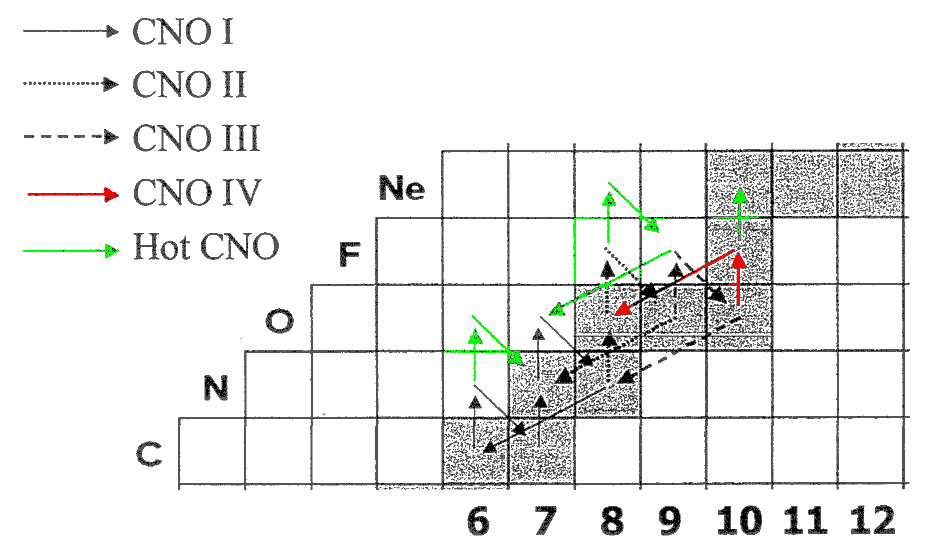§1.1 Stellar nucleosynthesis
…a star is a gravitationally controlled thermonuclear reaction in the sky.
Many astronomical phenomena require detailed knowledge of nuclear reactions
for adequate explanation. For example, it is well known that the sun, the
source of nearly all the energy which fuels our society, is itself fueled by
the fusing of hydrogen into helium. Observations of solar neutrinos at
Kamioka, Japan
[Fukuda, Fukuda et al. 2001] and in
Sudbury, Ontario
[Ahmad, Allen et al. 2001] have confirmed
this fact beautifully.
Balancing gravitational pressure with radiative pressure produced by the
heating of their interiors by nuclear reactions stabilizes stars like our sun.
Put another way, the stellar matter (mostly hydrogen) is squeezed to such high
temperatures (average energy) and densities that nuclei are able to overcome
their electrostatic repulsion and fuse with one another. The most typical
pathway for this is called the pp-I chain:
| p(p,e+ν)d(p,γ)³He(³He,2p)4He |
(1.1) |
| Net Result: 4¹H → 4He + 2e+ + 2ν +26.73
MeV |
In our sun, two other sequences, the pp-II and pp-III chains, are responsible
for another 14% of the fusions. The amounts of energy lost to the neutrinos,
which escape without interacting, differ slightly among the chains.
A second important fusion process is burning through the CNO cycles. This
process catalyzes the fusion using existing stable carbon and nitrogen in the
star. Mostly it burns through the CNO-I cycle:
| ¹²C(p,γ)¹³N(e+ν)¹³C(p,γ)14N(p,γ)15O(e+ν)15N(p,α)¹²C |
(1.2) |
At low temperatures and densities (T < 50 MK, ρ < 100 g/cm³), the rate of this
cycle is limited by the 14N(p,γ)
reaction [Weischer Görres at al.
1999]. For approximately one cycle in 1000, 15N captures
a proton instead of cycling back to ¹²C in the
CNO-II cycle:
| 14N(p,γ)15O(e+ν)15N(p,γ)16O(p,γ)17F(e+ν)17O(p,α)14N |
(1.3) |
There is some additional leakage out of CNO-II to the nucleus 18F
via the CNO-III cycle:
| 17O(p,γ)18F(e+ν)18O(p,α)15N |
(1.4) |
For about one cycle in 150, the 18O may capture a proton instead.
If the resulting 19F cycles back to 16O via (p,α), this
is called the CNO-IV cycle. Alternatively, the 19F may capture a
proton into 20Ne upon which protons may be converted into alphas by
the faster Ne-Na cycle. The ratio of the
19F(p,γ) rate to the
19F(p,α) rate is small and very
uncertain [Weischer Görres at al.
1999].
At high enough temperatures (e.g., 150 MK at
densities of 100 g∙cm-3), the CNO cycles are turned into the
“hotCNO” cycle. In the hotCNO cycle, proton capture proceeds to the drip line
[Weischer Görres at al.
1999]:
| I: ¹²C(p,γ)¹³N(p,γ)14O(e+ν)14N(p,γ)15O(e+ν)15N(p,α)¹²C |
(1.5) |
| II: 16O(p,γ)17F(p,γ)18Ne(e+ν)18F(p,α)15O |
The hotCNO cycle is the primary energy generation process in novae. Note that
the rate at which this cycle operates is limited by the
β+-lifetimes of the 14O (τ = 1.70 minutes) and
15O (τ = 2.94 minutes) nuclei. These lifetimes, unlike the capture
reaction rates, are independent of temperature. Any point in a nuclear burning
process where β-decay is the dominant path is called a “waiting point”. The
waiting point nuclei 14O, 15O and 18F shown
in (1.2), (1.3),
(1.4) and (1.5) may have important
roles in explosive nucleosynthesis. We will focus on the latter two:
15O and 18F.
One proposed alternative path to the A>18 region is the alpha-capture
reaction on 15O. One of the purposes of the measurement described
in this document is to constrain the possible values for this reaction rate.
The rate of 18F(p,α) is one factor
determining the temperatures and densities at which the hotCNO cycle may
operate. In novae, proton-induced reactions on 18F play an
astronomically observable role described in more detail below
[Weischer Görres at al.
1999].
